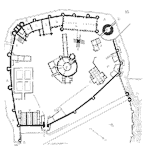
What you will learn from this article.
- The life of a road depends on the vehicle wheel loading.
- Aggregate size determines the strength of the tarmac.
- The sub-base below the tarmac distributes wheel forces.
- Slope the surface to prevent water pooling.
Your Reliability Engineering Professional Development Site
Find all articles across all article series listed in reverse chronological order.

What you will learn from this article.
by Fred Schenkelberg 10 Comments

As with strength-strength analysis, derating is a means to design robust systems.
Derating is an intentional process applied to every component of a product to reduce the opportunity of a component witnessing more stress than it is capable of withstanding.
The additional robustness also reduces the amount of damage the stress may impart, thus prolonging the life of the component. [Read more…]
by Fred Schenkelberg 4 Comments

The component choice an electrical engineer starts with the functional requirements of the circuit. Another consideration is the rated values of the specific component selected.
Derating guidelines provide information to compare the component rated values to select stresses or conditions. The intent is to assist the engineering team to select robust enough components for the application.
Robust here implying the component within the circuit will operate for a suitable length of time. [Read more…]
by Tim Rodgers Leave a Comment

It’s hard enough to get people to focus on quality when their company’s name is on the product.
It’s even more challenging when the design and/or manufacturing of the product is outsourced. How do you effectively manage product quality indirectly through suppliers and subcontractors?
by James Reyes-Picknell Leave a Comment

Welcome to my latest 10-part series of blogs called “Uptime Insights”, where we explore a journey of excellence in maintenance. To stay on top, managers must implement strategies that keep operations performing at high levels. In these articles I will show you how to achieve excellence in maintenance – a critical business process in any capital intensive industry. [Read more…]
by Mike Sondalini Leave a Comment

Roll mills, drum dryers, kilns, ball mills and rotating reactors usually turn on metal tyres and trunnion rollers.
Eventually, the tyres and rollers wear out or fatigue and require repair or replacement.
Usually, the equipment manufacturers keep material specifications as proprietary information and one is forced to buy the parts from them. [Read more…]
by Greg Hutchins Leave a Comment

Guest Post by Ed Perkins (first posted on CERM ® RISK INSIGHTS – reposted here with permission)
Risk-based decision making is employed to implement risk management.
But how is this implemented? In this article, we will look at the process of making “risk-based” decisions.
by Fred Schenkelberg Leave a Comment

The ASQ CRE Exam is daunting.
While you may desire to become certified, you also know the CRE body of knowledge is broad. The exam is 150 questions in four hours that may tax your ability to achieve a passing score.
There is a lot to know in reliability engineering. Your journey of learning really never ends. [Read more…]
by Fred Schenkelberg Leave a Comment

Data and the analyses that use the data can be tricky to manage at best, let along extremely difficult.
In this last post of the series on using the maintenance data you have, Fred and James will answer many of the common questions asked about data and the analyses. [Read more…]
by Fred Schenkelberg 1 Comment

By the time a product fails in the field, the design team is focused on the next design.
They are looking to the future and not looking for field reliability feedback. We know that each failure contains valuable information.
We, as reliability professionals, often work to create as much useful information concerning failure modes and mechanisms as possible. We want to improve the design.
Yet, what happens when the design team has moved on to the next project? When the expertise to effectively make changes to the design to improve product reliability performance is no longer paid to work on the previous design?
What can you do to engage the right people to implement the necessary changes?
Here are a few ideas that I’ve seen used to effectively make good use of field failures to create meaningful field reliability feedback. [Read more…]
by Tim Rodgers Leave a Comment

When I joined Hewlett-Packard in 1988, I was assigned to a team that was working on a design for manufacturability manual for printed circuit board designers.
Our primary objective was to provide performance and cost information that could be used to guide decisions about different design options.
My favorite project during that time was a predictive model to estimate the manufacturing yield of a PCB design based on a composite “complexity” metric.
Because we were an internal supplier, I was able to look at the actual lot yields for hundreds of active part numbers with known design parameters, so it seemed like a fairly straightforward exercise to experiment with different regression models to find an optimum fit between complexity and yield.
by James Reyes-Picknell Leave a Comment

We know that there are no “quick fixes” or “silver bullet solutions” when it comes to improvements in maintenance management.
In my last article, I pointed out that many separate conditions and events must come together properly to achieve “schedule success” – i.e.: the high level of compliance to a schedule of planned work as produced by your planners.
That list of includes: [Read more…]
by Mike Sondalini Leave a Comment

What you will learn from this article.
Fixing plant and equipment about which you know little is daunting.
Here are a few ideas to help you successfully fault find failed equipment. [Read more…]

Guest Post by James Kline (first posted on CERM ® RISK INSIGHTS – reposted here with permission)
On March 28, 1979, there was a cascading failure in reactor number 2 at Three Mile Island.
This failure allowed large amounts of nuclear reactor coolant to escape. The accident coalesced the anti-nuclear movement and ultimately caused the decline in nuclear plant construction in the United States. [Read more…]
by Fred Schenkelberg 2 Comments

As seen in the previous articles, you can easily use the data you already have to conduct a meaningful analysis. This includes Weibull, Crow-AMSAA or a Mean Cumulative Function analysis.
Digging into a well manage dataset promises to reveal insights, trends, and patterns that will help improve the line, process, or plant.
Creating a plot or calculating summaries is pretty easy with today’s tools. Yet, are you doing the right analysis or are the various assumptions valid?
One critical step in the data analysis process is making sure you are doing a valid and appropriate analysis. [Read more…]